Abstract
With the development of urbanization, urban public safety is becoming more and more important. Urban public safety is not only the foundation of urban development, but also the basic guarantee for the stability of citizens’ lives. In the context of today’s artificial intelligence (AI), the concept of smart cities is constantly being practiced. Urban public safety has also ushered in some new problems and challenges. To this end, this article aimed to use AI technology to build an efficient public safety data resource management system in a smart city environment. A major goal of AI research was to enable machines to perform complex tasks that normally require human intelligence. In this article, a data resource management system was constructed according to the city security system and risk data sources, and the data processing method of neural network (NN) was adopted. Factors affecting urban public safety were processed as indicator data. In this article, the feedforward back-propagation neural network (BPNN) was used to predict the index data in real time, which has realized the management functions of risk monitoring and early warning of public safety data indicators. The BPNN model was used to test the urban risk early warning capability of the constructed system. BPNN is a multi-layer feed-forward NN trained according to the error back-propagation algorithm, which is one of the most widely used NN models. The results showed that the average prediction accuracy of the BPNN model for indicator prediction was about 89%, which was 16.1% higher than that of the traditional NN model. The average risk warning accuracy rate of the BPNN model was 90.3%, which was 16.5% higher than that of the traditional NN model. This shows that the BPNN model using AI technology in this article can more efficiently and accurately carry out early warning of risk and management of urban public safety.
1 Introduction
According to the current status of smart city construction, its public security threat is increasing day by day, which has caused social disorder and social unrest. In the process of building a smart city, the consumers are citizens, builders, and managers. Factors such as the low comprehensive quality of citizens, the imperfect talent system, and the decision-making bias of managers have all become obstacles to the construction of smart cities. At the same time, the characteristics of the organizational structure of big cities determine the growing demand for technology and talents. The high concentration of factors such as population size, population density, social mobility, and complexity makes it a complex spatial place. From the perspective of social development and change, China is currently in the process of urbanization and there are many risks. For example, the urban security system is not perfect. Urban security is not in place, and environmental security is not guaranteed. From a spatial perspective, the development of smart cities is in a high-risk social stage. To this end, it is urgent to build a data resource management system that can understand urban public safety at any time, which is used to perform risk assessment and early warning of factors that may endanger urban public safety in advance. In this article, the smart city public safety management system constructed by back-propagation neural network (BPNN) can effectively realize the management capabilities of city risk assessment and early warning.
The innovation of this article is to construct a new data resource management system and to propose a method to predict data by using the BPNN model. This article uses retrospective thinking to analyze relevant literature and summarize the shortcomings of traditional research in application. Meanwhile, in the experimental part of Chapter 4.2 this article trains the neural network (NN) model multiple times. In the experimental part of Chapter 4.3 the test results of the BPNN model and the traditional NN model are compared, and the effect is more obvious.
2 Related work
Urban public safety is the basic guarantee for people to live and work in peace and contentment. Regarding the management of urban public safety, some scholars have conducted related research. Among them, Editorial E proposed an urban public safety application of a multi-sensor imaging system, that is, an artificial intelligence (AI)-based target detection smart device subsystem, which could be used to activate target tracking [1]. Arbuckle used communication technology to warn the public of imminent fire and evacuation orders, which was beneficial to maintain urban public safety [2]. Paul developed an urban security communication system to make city management smarter and people’s lives safer [3]. Oliveira and Santos investigated the factors affecting the acceptance of information disclosure in public safety in the context of smart cities [4]. Although the aforementioned studies have promoted the construction of urban public safety to a certain extent, most of them are based on theoretical foundations. There are few specific application and implementation methods. Therefore, further research is needed.
To this end, some scholars proposed to use AI technology to manage the data resources of smart city public safety. Among them, Wu et al. proposed an AI-based framework for efficient resource management in mobile multi-user radio frequency-optical heterogeneous networks [5]. Lin and Zhao reviewed the state-of-the-art AI resource management from a framework perspective to a methodological perspective, considering not only radio resource management but also many other types of resources [6]. Qi and Yao proposed that the key exploration tools of AI and machine learning could be used in hardware accelerators, which could be used in urban emergency safety rescue and other aspects [7]. These methods have strong practicability and can implement the theory into specific applications, but the cost of these methods is high. The practical application is not mature enough. Therefore, further improvement is required.
3 Smart city public safety management model
3.1 Smart city
In recent years, the intelligent construction of cities has been deepening. There is also an increasing amount of research on smart cities. The concept of a smart city is shown in Figure 1. A smart city is a city that has the human brain for self-thinking and judgment, and it is also a city that is fully digitalized, networked, and informatized. Smart cities include municipal, education, health, real estate, transportation, public utilities, and public safety, which are more interconnected, efficient, and smart. It provides citizens with better life and work services and creates a more favorable business development environment for enterprises. It also enables the government to operate and manage more efficiently. With the popularization of the concept of “smart,” the construction of smart cities in some areas has achieved initial results. People’s living standards have been improved. Managers’ grasp of management information has become more and more accurate, and enterprises have also found business opportunities from it.
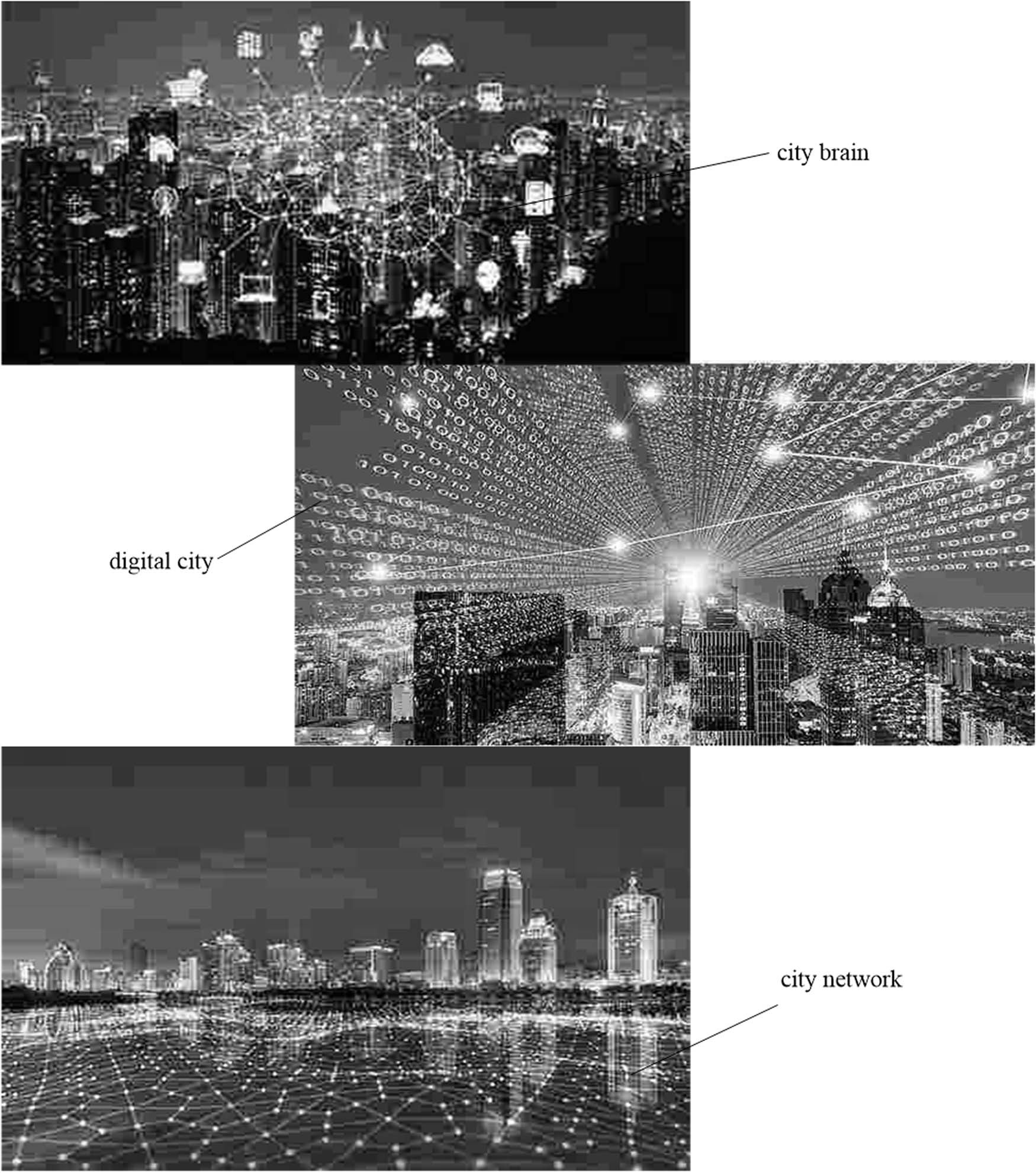
Schematic diagram of a smart city.
However, scholars have different views on the basic issue of “smart city.” In the research on smart cities, people mainly define and recognize smart cities from the aspects of technology and economy. From a technical point of view, a smart city is to use scientific and reasonable information technology and communication technology to give full play to the role of the network to narrow the digital divide and achieve information sharing. The social risk assessment of participatory smart city construction is used to make decision-making subjects more scientific and rational in the management of cities and environment. At the same time, the scientific distribution and utilization of human capital, social capital, and natural resources are promoted [8,9]. From the perspective of urban strategy, a smart city is a planned and systematic investment in new information and communication technologies to achieve social prosperity and stability. The informatization of smart cities is a concrete manifestation of promoting urbanization. Its essence is to develop in a new way, in a new form, and in a new way in a specific time and space [10].
According to relevant research on smart cities, it is easy to find that there is a certain relationship between smart cities and concepts such as smart cities, digital cities, ecological cities, and sustainable cities. The construction of smart cities is an important link in the penetration of information technology into various fields. The biggest difference between two smart cities is that its core smart city lies in the “intelligence of things.” Smart cities emphasize the application of smart services and smart technologies. Smart cities emphasize the idea of putting people first [11,12]. A digital city is an extension of the digital earth. The development of geographic information system has played a role in promoting the development of digital earth. Smart cities play an important role in the development of digital cities. A digital city is a form of city that combines the virtual and the real with the Internet as the carrier. Eco-city is a low-carbon energy city characterized by the development and recycling of clean energy. On the premise of meeting the needs of ecological capabilities, smart cities and eco-cities have similarities at the technical level. However, there are big differences in the specific implementation. Smart cities improve comprehensive decision-making and emergency response capabilities through the use of traditional environmental protection technologies and real-time monitoring of the environment through smart devices. A smart city is an emerging city. It is produced along with the sustainable development of cities [13,14]. Sustainable development is a basic need for urban development. Its implementation is also varied. The core of a smart city is to use modern information technology to optimize the urban environment, so as to achieve the sustainable development of the city. Generally speaking, smart cities are increasingly people-oriented and focus on serving the people and protecting the environment, which is an advanced urban management method proposed in the past [15].
Current specific applications of smart cities include smart healthcare, smart transportation, smart education, and smart factories, as shown in Figure 2. In smart medical care, AI robots are used for diagnosis and mechanical treatment. In smart transportation, intelligent traffic analysis and navigation are used. In smart education, remote classroom teaching and online assignments are intelligently corrected. In smart factories, intelligent robots are used to automate production and supervision [16]. With the advancement of science and technology, smart cities have become an important way for city builders to solve urban problems, improve urban management, and promote sustainable urban development. At present, the construction of smart cities in China includes many fields such as environmental monitoring, green technology, transportation planning, and medical insurance. In pilot cities, issues such as urban management efficiency, quality of life, attractiveness, and sustainable development have drawn increasing attention. In addition, in terms of smart cities, it has great investment potential and is also very beneficial for promoting economic development. It is believed that with the continuous development of informatization and automation, the application of smart cities become more and more extensive [17].
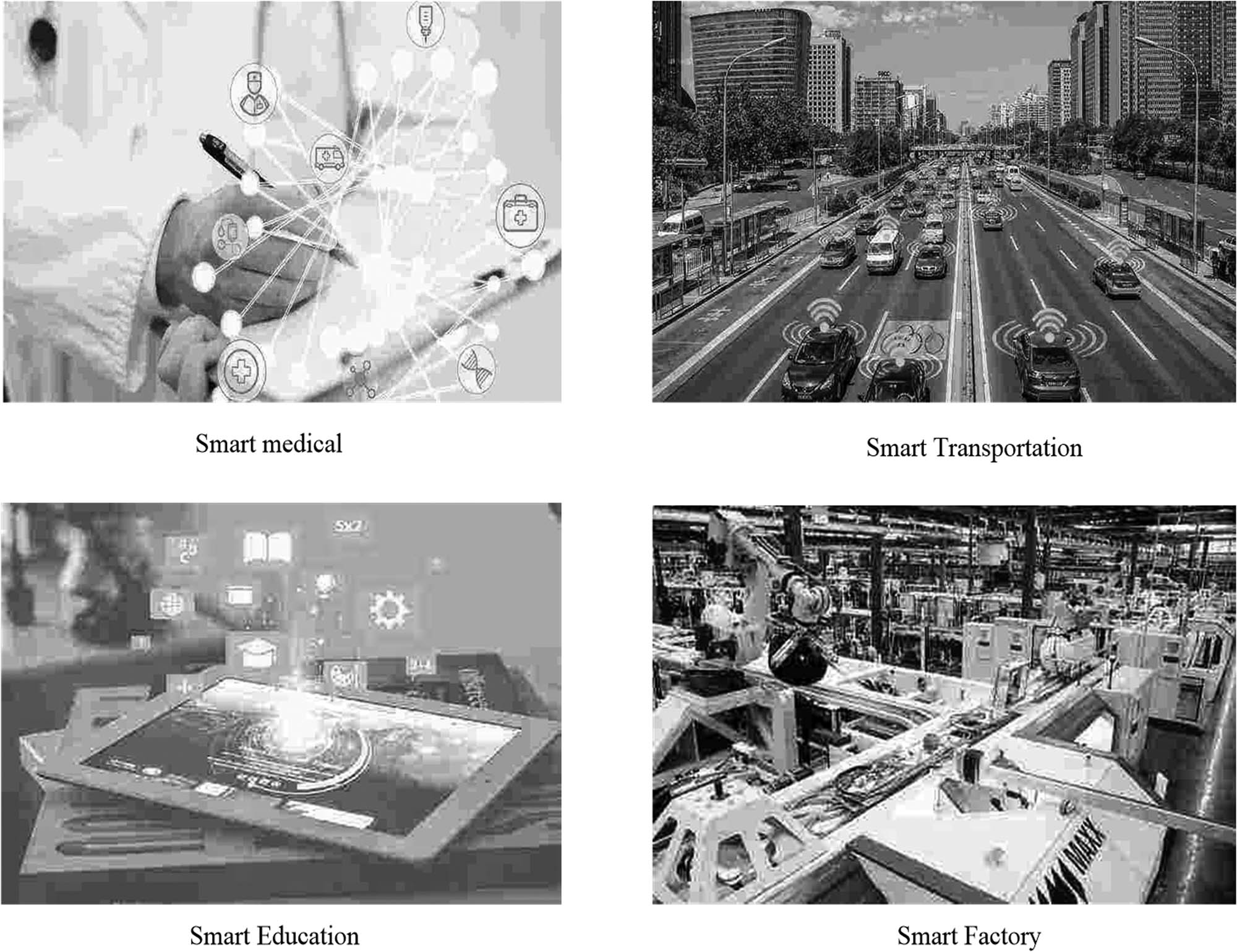
Specific applications of smart cities.
3.2 Urban public safety
With the acceleration of urbanization in China, urban public safety management has become an important part of urban public security management. With the continuous development of smart city economy, politics, and civilization, the governance of social security risks in China has been paid more and more attention. China’s urban public safety risk management system is just in its infancy. Both in theory and in practice, they are far behind the needs of economic development. Therefore, it is necessary to deeply study the risk sources, risk management, and risk prevention methods of urban public safety to establish a relatively mature data resource management system [18]. The technical prevention of public safety management and prevention is mainly based on security prevention technology and based on the development of human prevention work to establish a combination of detection, delay, and response functions.
The types of public hazards in cities can be roughly divided into natural disasters, accidental disasters, influenza virus spread, and terrorist attacks, as shown in Figure 3. In recent years, a series of urban security problems, such as severe acute respiratory syndrome, bird flu, a series of terrorist attacks in Xinjiang, and the Tianjin Port explosion, also show that there are many loopholes in urban public security. At present, based on the analysis of social risks in China, there are problems such as institutional transformation risks, information flow and control risks, ecological risks, abuse risks, diversification risks, financial risks, and life risks. However, judging from the current public security management, there is more to be carried out regarding emergency treatment, and this management method has become increasingly unsound [19].
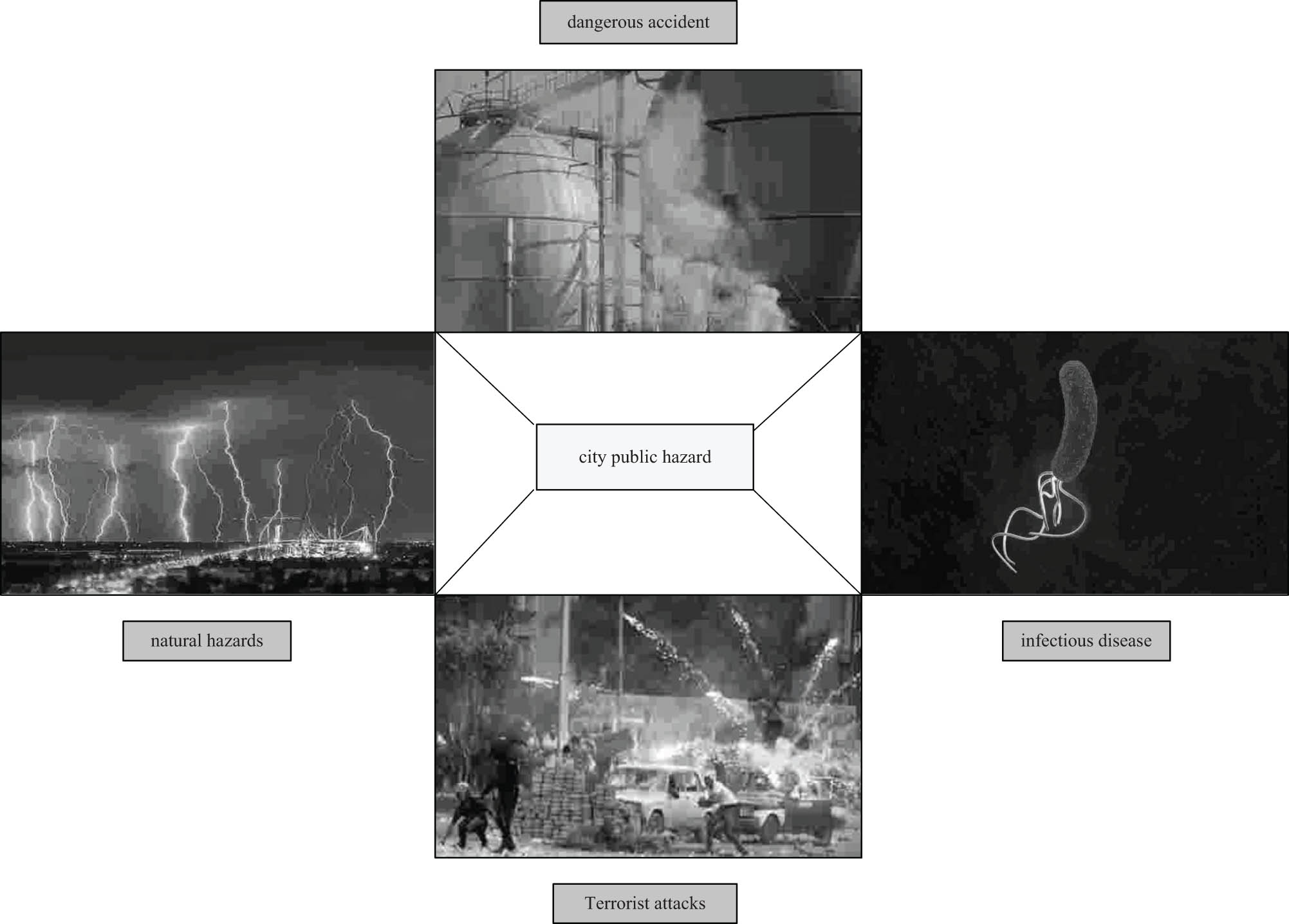
Urban hazard types.
In order to establish a city’s management system, it is necessary to analyze the factors that affect the city’s public safety. The factor analysis of urban public safety should be carried out from many aspects, specifically including urban environmental security, resource consumption security, water quality security, food security, energy security, and power security. Urban public safety depends not only on government management, but also on the self-monitoring and self-discipline of urban residents. Second, safety mainly refers to the safety of people’s daily life, as well as the safety in crowded places, including the safety of fire, traffic, public security, and so on. On the whole, urban public safety management is divided into emergency public security management, public health emergency, medical emergency, and public facility emergency management. The main factors affecting urban public safety can also be analyzed according to their contents, as shown in Figure 4, which includes the level of urban public security management, urban fire and security, urban supervision and management, and urban medical care.
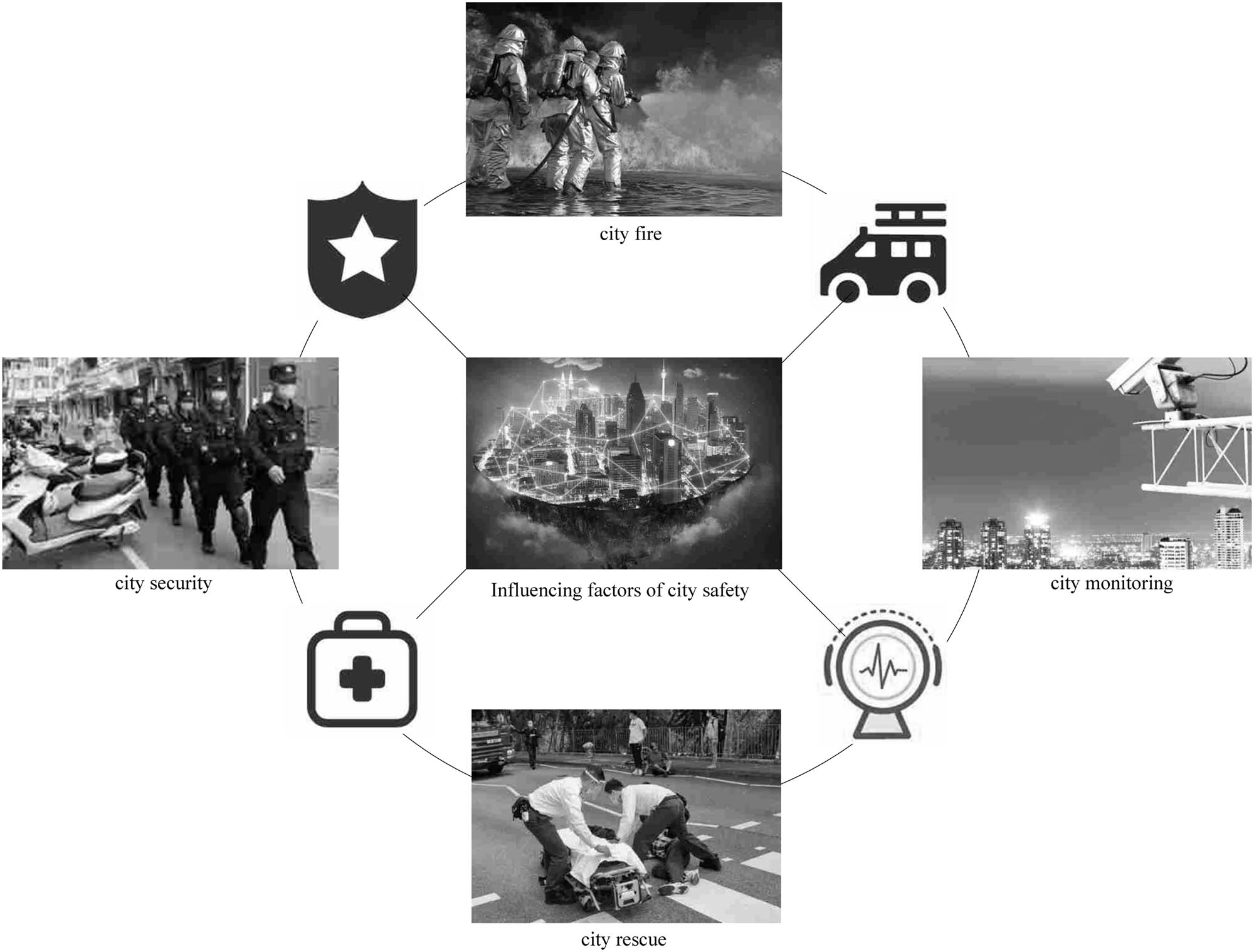
Factors affecting urban safety.
After understanding the influencing factors of urban security, how to build an efficient urban security system can be studied. The urban safety management system constructed in this article is mainly composed of emergency system, early warning system, and safety education system, as shown in Figure 5. The implementation of these systems is mainly carried out from the aspects of production safety, food safety, construction safety, fire safety, and natural disaster monitoring.

Urban safety management system.
In recent years, China’s urban emergency management has achieved certain results. However, facing new tasks and new opportunities, there are still many problems, because it does not understand that the risk itself is a great danger. There are a large number of macroscopic, qualitative, and quantitative studies in the risk assessment and analysis of enterprises by urban management. There is still a big gap in the field of intelligent monitoring and intelligent perception using big data, cloud computing, sensors, and other information technologies. Once a threat to public safety management occurs, no matter what effective and rapid measures are taken, it would inevitably cause harm to personal and property safety to a certain extent. Therefore, the most effective way to deal with public security incidents is to establish a security management and risk management system so that public hazards are within the controllable range of people.
3.3 Data resource management
At present, China’s demand for smart city construction is growing. However, the current security data resource management methods can no longer meet the needs of urban development, especially the research on smart city technology and risks. Although there are some relatively perfect theories and methods, they have not been comprehensively discussed from the system and other aspects. The existing research does not distinguish the risks of urban informatization and smart cities. Although there is a connection between the two, their causes and manifestations are different [20].
With the development of science, technology, and economy, the public safety management of enterprises is gradually developing in a quantitative direction. Based on a probabilistic approach, risk prediction is carried out and effective intervention and management is carried out. Public security management has a history of a hundred years in China. The first is the development and application of public safety management theory. The government prioritizes public safety management and new developments. Second, in the early twentieth century, with the acceleration of western urbanization, the application of public safety management ideas in enterprises became more and more common. The public safety management of corporate finance and personnel has been guarded to a certain extent. The main means of public safety management is insurance as the core. With the passage of time, public safety management has gradually become a scientific form and has been valued by more and more experts and scholars [21,22].
To this end, this article first analyzes the sources of public safety data. Then, further resource management is done. Through research, it is learned that the public safety data resources of smart cities mainly come from meteorological monitoring data, geographic survey data, customs inspection data, forest fire management data, aerial reconnaissance data, and urban ground monitoring network data, as shown in Figure 6. For this reason, in the management of public safety data, these data can be analyzed and processed. The risks existing in them can be evaluated, and the specific values can be converted [23].
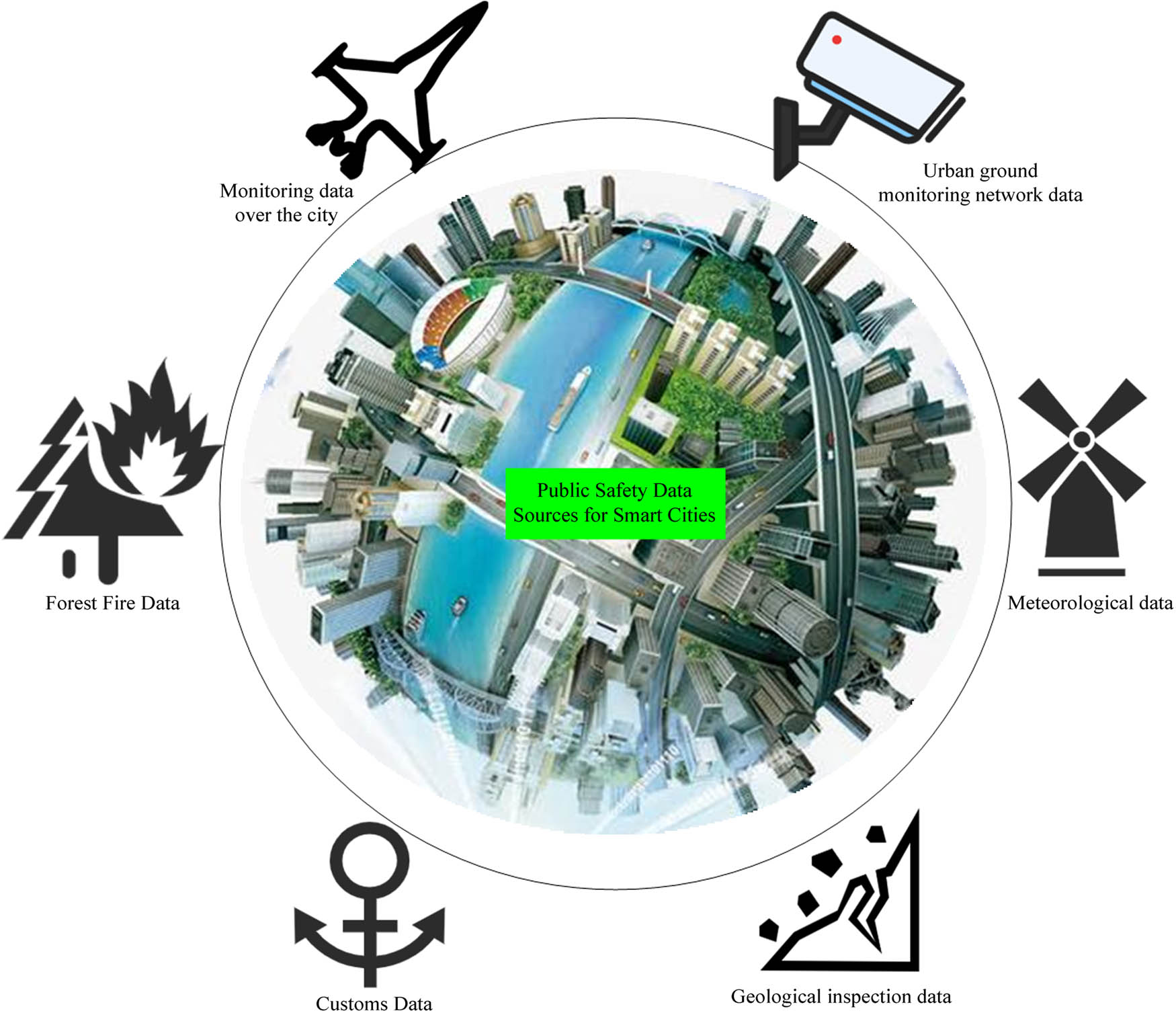
Public safety administration data sources.
In addition, the data resource management system constructed in this article is shown in Figure 7, which includes a variety of security management requirements. The figure explains the system from data solution to the specific operation and processing of the data. The ultimate goal is to realize the value of data. Among them, the standardization of risk prediction, early warning, and control and evaluation procedures of smart cities are important breakthroughs in China’ security risk management.
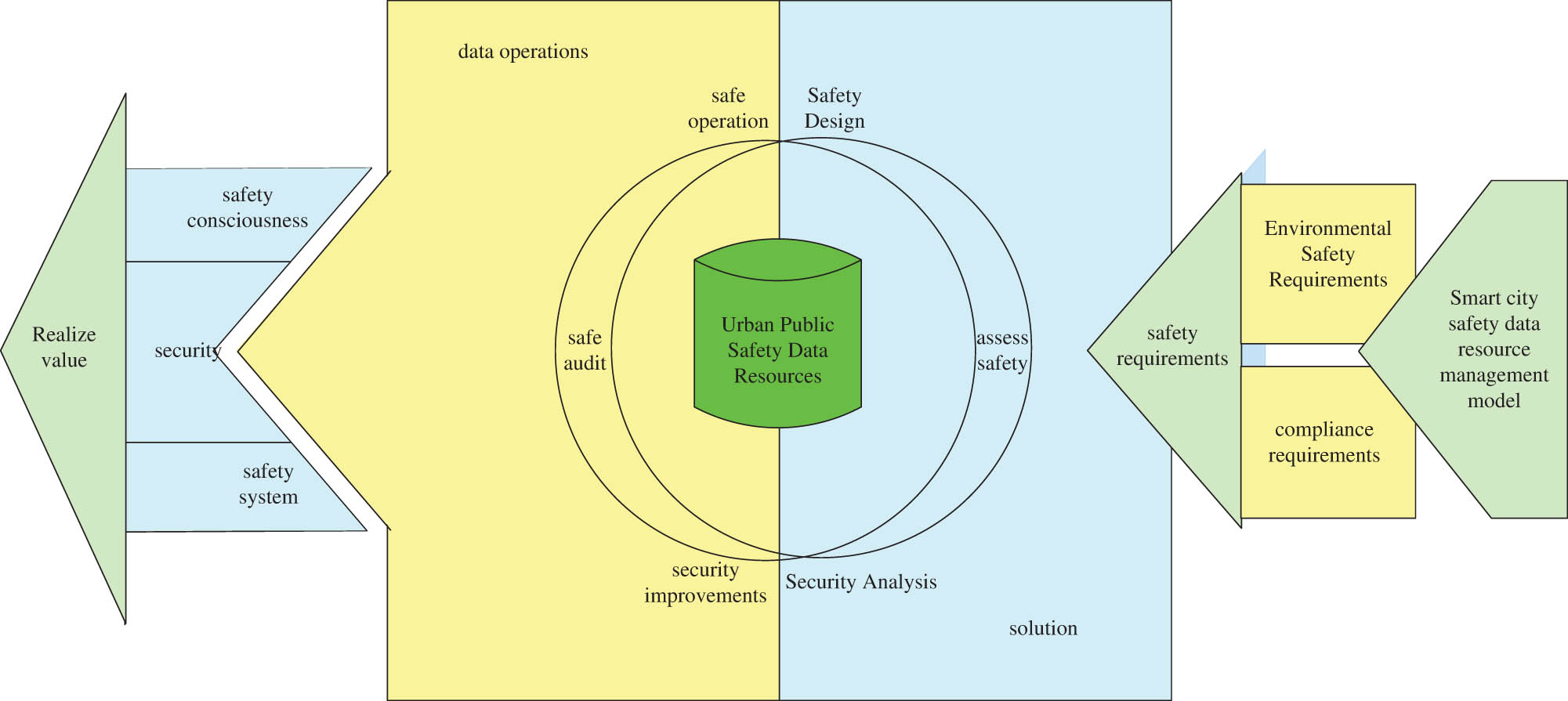
Data resource management system.
Finally, the specific application of AI in smart cities is shown in Figure 8, including intelligent weather warning, robot city patrol, drone reconnaissance, and urban intelligent network monitoring. In the weather warning, the weather and geological conditions of the city can be monitored in real time. For example, if heavy rainfall, typhoon, or tsunami is imminent, the system would automatically issue an alarm. When natural disasters such as earthquakes, fires, and floods occur, the system can also monitor and process satellite signals and issue an alarm, so that firefighters can go to rescue in time. In unmanned aerial vehicle reconnaissance, the environment over the city can be detected at any time. At the same time, the presence of foreign aircraft can be observed in the sky to prevent sudden enemy attacks or flight accidents. Using the urban patrol robot, some troubled areas can be patrolled 24 h a day. It can also monitor some unobserved corners, which more effectively ensures the level of public security in the city.
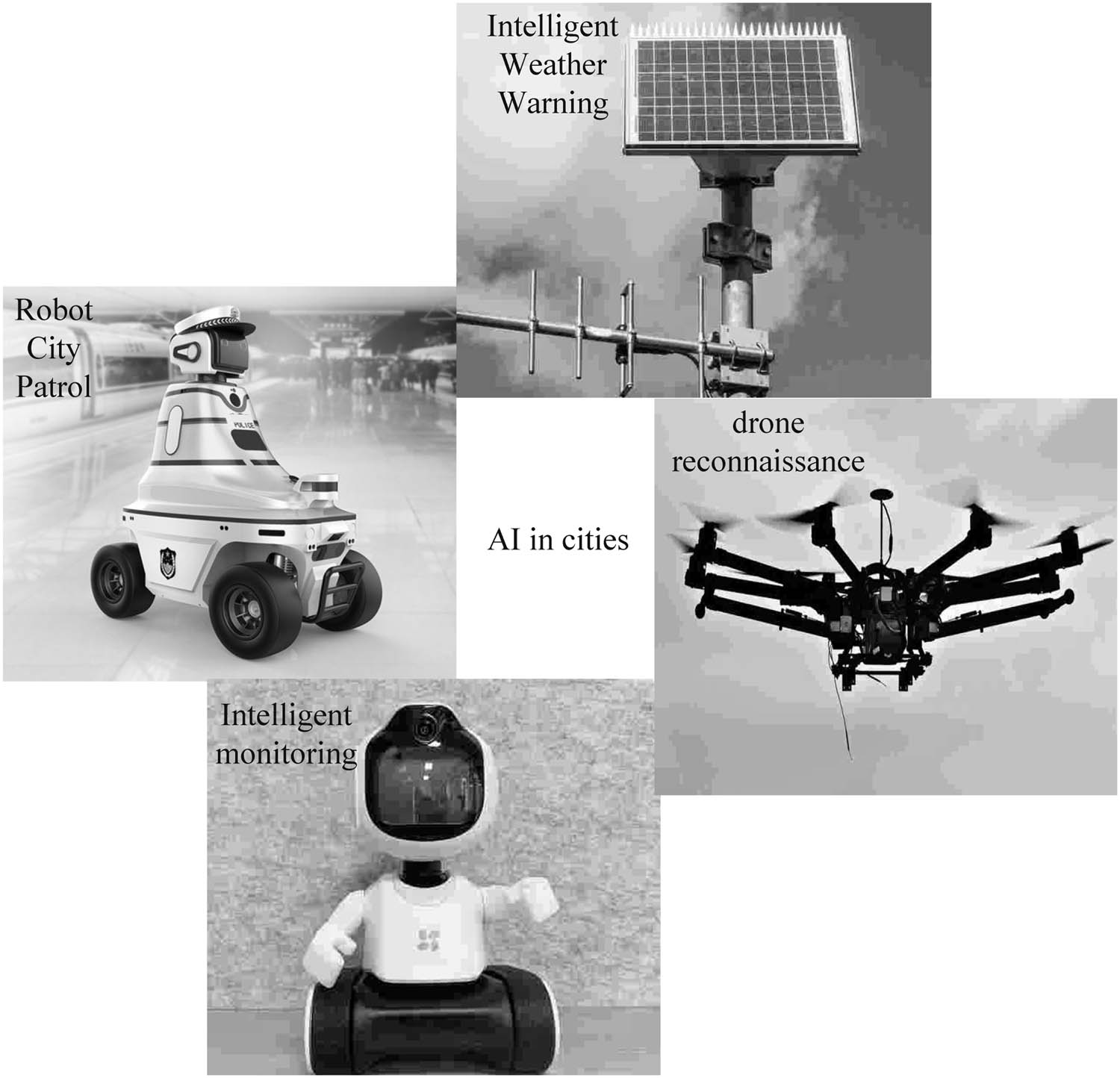
AI applications in smart cities.
3.4 BPNN
BPNN is often used for data classification, prediction, etc. This article uses the BPNN algorithm to predict the public safety data of smart cities, so as to distinguish and warn the danger sources that may endanger public safety in advance. The calculation method of BPNN is as follows:
Assuming that the total risk value of public safety is I, the source of risk has n factors. There is a certain relationship F between the total risk and each factor; the total risk value can then be expressed as:
The probability of occurrence of a public safety accident is represented by K, which is expressed as:
BPNN simulates the human brain to perform operations. If the output value of the NN is the risk value, the input value is the relevant monitoring data x. Then, the relationship between the two is as follows:
where w is the weight and θ is the offset.
When passing the output value to the next neuron, it needs to use the activation function f to realize, that is, the final neuron output y as follows:
The commonly used activation function is the sigmoid function, which is:
where −β is the inclination.
The hyperbolic tangent function is given as follows:
The step function is given as follows:
In special cases, even Gaussian functions are used as follows:
where
The variance between the expected output of the node j of the
Equation (9) then becomes the following:
where
Weight is adjusted during back-propagation as follows:
where
When
Combining equations (11) and (13), the following can be obtained:
When the
where t represents the node of the
The final weight increment
4 Experiment design and test of management system
4.1 System development process
The development environment of the smart city public safety data resource management system constructed in this article is shown in Table 1. It can be seen from Table 1 that the Linux system is used, and the development language is Python. Python is chosen because the language is easy to compile, easy to understand, and fully functional. MySQL database is selected as the data source for experimental training and reference.
System development environment
| Code | Development environment | Details |
|---|---|---|
| D1 | Computing system | Linux XP |
| D2 | Development language | Python |
| D3 | Development tool | PyCharm |
| D4 | Database | MySQL |
In addition, this article uses Python to monitor urban traffic and weather data to better maintain urban public safety. The traffic safety monitoring codes are as follows:
import numpy as np
import pandas as pd
data_origin = pd.read_csv(“180508.csv”,header = None,encoding = ‘GBK’,
names = [“card”,“date”,“time”,“station”,“way”, “money”,“transaction.nature”],
dtype = dict(zip([3,4,6],[“category”]*3)))
data_origin.head()
data_stations = pd.read_csv(“station.csv”,encoding = ‘GBK’)
data_stations.head()
Through the aforementioned methods, the data of the main traffic rail stations in the city can be obtained, so as to realize the function of traffic data monitoring or accident early warning.
In addition, the urban air quality monitoring codes compiled in this article are as follows:
N = 24
theta = np.linspace(0.0, 2*np.pi, N,endpoint = False)
radii = a24h
width = 2*np.pi/N*2
ax = plt. subp1ot(111, polar = True)
ax.set_ theta_ direction( -1)
ax. set_ theta_ offset(np.pi/2.0)
ax.set_ xticks(np. linspace(e, 2*np.pi, 24, endpoint = False))
ax. set_ xticklabels(range(24))
bars = ax.bar(theta, radii, width = width,bottom = 0.0)
r_ max = radii.max()
for r,bar in zip(radii, bars):
bar. set_ facecolor(plt.cm. jet(r**2/r max-*2))
bar.set_ alpha(0.5)
Plt.show()
Using this method, 24-h monitoring of urban air environment can be achieved. It can also realize early warning when urban smog, PM2.5 particles, exceed the level during standard or natural disasters, thereby improving urban public safety.
4.2 System test experiment design
In this article, BPNN is used to predict data, and the BPNN model needs to be trained on data before testing. To this end, this article divides the data samples into training and testing groups. The relevant parameter settings of the two groups are shown in Table 2. Among them, the training group includes 600 data samples and 50 training nodes. The test group consists of 100 samples and 20 test nodes.
System test-related parameters
| Group | Training group | Test group |
|---|---|---|
| Sample book | 600 | 100 |
| Power | 40 W | 30 W |
| Network | 4 G | 4 G |
| Number of nodes | 50 | 20 |
Finally, this article selects the risk assessment indicators shown in Table 3, mainly including urban information security, urban environmental security, citizens’ moral literacy, and urban diplomatic security. The values of these indicators are predicted using the BPNN model. When the predicted value may exceed the critical value, the system would issue an alarm to realize the early warning function.
Risk assessment indicators
| Code | First-level indicator | Secondary indicators |
|---|---|---|
| F1 | Information security | Communication infrastructure level |
| Information encryption and protection level | ||
| F2 | Environment safety | Monitoring level of natural environment |
| The level of road traffic management | ||
| F3 | Moral literacy | Moral education and awareness levels |
| F4 | Diplomatic security | Diplomatic level |
4.3 Results and discussion of management system testing
In this article, in order to make the BPNN model have sufficient training accuracy, the training samples are divided into two times. Each time is 300 groups of samples. The training data accuracy is compared with the traditional NN model, and the results of the two trainings are shown in Figure 9.
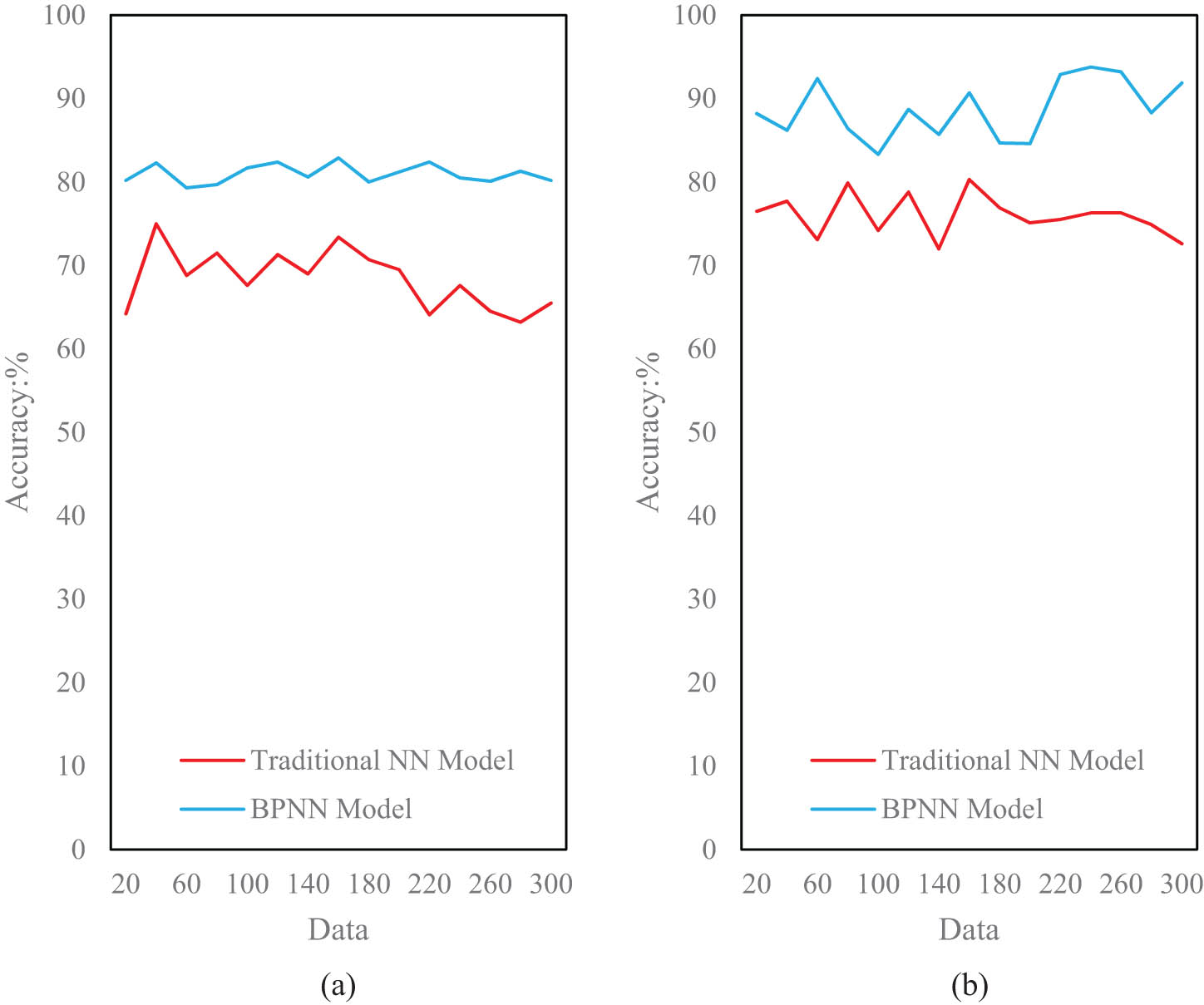
Data training results. (a) The first training result and (b) the second training result.
As can be seen from Figure 9(a), in the first training, the accuracy of the traditional NN model is only 63.2% at the lowest, 75% at the highest, and only 68.4% on average. The accuracy of the BPNN model is the lowest at 79.3% and the highest at 82.9%. The average is about 81%, which is about 12.6% higher than the traditional NN model. However, this does not meet the accuracy required by the test. After the second training, it is known from Figure 9(b) that the lowest accuracy of the BPNN model is 83.3% and the highest is 93.8%. The average accuracy is 88.7%, which has met the basic test requirements. The highest accuracy of the traditional NN model is only 80.3%, and the average accuracy is only about 76%. This shows that the training speed of the BPNN model is faster and the accuracy is higher.
After the BPNN model has sufficient accuracy, it is then subjected to systematic data testing. By calculating and predicting each index of the public safety data resource management system, the prediction results of the model are summarized. The prediction accuracy and the correct rate of risk warning are compared with the traditional NN model, and the results are shown in Figure 10.
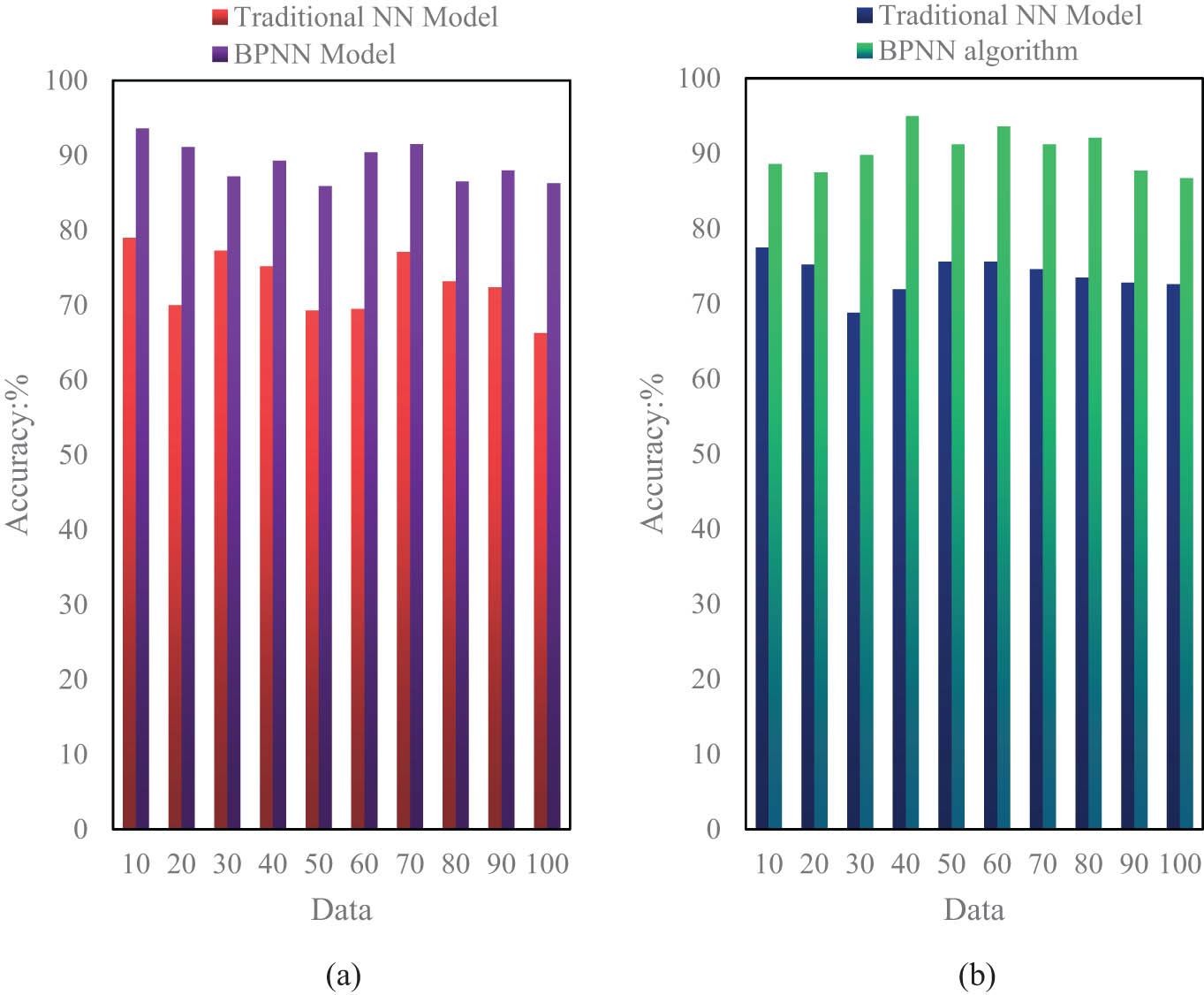
Risk assessment capability. (a) Index prediction accuracy and (b) risk warning accuracy rate.
It can be seen from Figure 10(a) that the accuracy of the BPNN model for the prediction of indicators is not less than 85%. The highest among them is 93.6%, and the average prediction accuracy is about 89%. The accuracy of the traditional NN model is only 79% at the highest and 66.3% at the lowest. The average accuracy is only 72.9%, which is 16.1% lower than the BPNN model. In Figure 10(b), the risk warning accuracy of the traditional NN model ranges from 68.8 to 77.5%, with an average of 73.8%. The correct rate of risk warning of the BPNN model is 86.7–95%, with an average of 90.3%, which is 16.5% higher than that of the traditional NN model. Overall, this article uses the BPNN model in AI technology to test the data management system and achieves good results. It shows that the smart city public safety management system constructed in this article has certain stability and reliability.
5 Conclusions
In the future, China’s urbanization has led to an urgent increase in the urban population. Overpopulation has affected the development of the city to a certain extent. On the positive side, the increase in population has greatly contributed to the economic development of the city. On the negative side, the increase of urban population has been bounded to cause the city’s energy consumption, pressure on the urban environment, infrastructure, public resources, etc., especially in terms of public safety, resulting in greater hidden dangers. For this reason, in today’s AI era, the construction of a more efficient management system is very important. This article first made a relevant understanding of smart cities, and found that smart cities had more and deeper meanings with intelligent and digital cities. In addition, this article explained the types of public hazards in smart cities and built a public safety management system. Then, the source of the public safety data has been described. Finally, a data resource management system has been designed according to the data source. In order to understand the management effect of the system, this article used the BPNN model to test the risk assessment ability of the system. The results showed that the correct rate of risk warning of the BPNN model was 16.5% higher than that of the traditional NN model. The BPNN model was used to test the data management system in this article, which has achieved good results. However, this article still has many shortcomings. Among them, the research on public safety management is not deep enough, and the application of AI technology is not mature enough. Therefore, there is still room for improvement.
-
Funding information: Author received no financial support for the research, authorship, and/or publication of this article.
-
Author contributions: Author has accepted responsibility for the entire content of this manuscript and approved its submission.
-
Conflict of interest: There are no potential competing interests in our article. All authors have read the manuscript and approved to submit to this journal. We confirm that the content of the manuscript has not been published or submitted for publication elsewhere.
-
Ethical approval: This article abides by ethical standards.
-
Data availability statement: The data that support the findings of this study are available from the corresponding author upon reasonable request.
References
[1] E. Editorial, “Corrigendum on: Big Data and development of smart city: System architecture and practical public safety example,” Serbian J. Electr. Eng., vol. 18, no. 1, pp. 137–137, 2021.10.2298/SJEE2101137ESearch in Google Scholar
[2] J. Arbuckle, “Broadband deployment, public safety and defending local control,” West. City, vol. 95, no. 6, pp. 3–7, 2019.Search in Google Scholar
[3] S. Paul, “Public safety communications systems: THE FUTURE IS SMART,” Public. Saf. Commun., vol. 83, no. 3, pp. 14–15, 2017.Search in Google Scholar
[4] V. Oliveira and G. D. Santos, “Information technology acceptance in public safety in smart sustainable cities: A qualitative analysis,” Procedia Manuf, vol. 39, no. 4, pp. 1929–1936, 2019.10.1016/j.promfg.2020.01.239Search in Google Scholar
[5] Z. Y. Wu, M. Ismail, E. Serpedin, and J. Wang, “Artificial intelligence for smart resource management in multi-user mobile heterogeneous RF-light networks,” IEEE Wirel. Commun., vol. 28, no. 4, pp. 152–158, 2021.10.1109/MWC.001.2000424Search in Google Scholar
[6] M. Lin and Y. Zhao, “Artificial intelligence-empowered resource management for future wireless communications: A survey,” China Commun, vol. 17, no. 3, pp. 58–77, 2020.10.23919/JCC.2020.03.006Search in Google Scholar
[7] L. Qi and K. Yao, “Artificial intelligence enterprise human resource management system based on FPGA high performance computer hardware,” Microprocessors Microsyst, vol. 82, no. 3, pp. 103876–103876, 2021.10.1016/j.micpro.2021.103876Search in Google Scholar
[8] K. Dooley, “Direct passive participation: Aiming for accuracy and citizen safety in the era of big data and the smart city,” Smart Cities, vol. 4, no. 1, pp. 336–348, 2021.10.3390/smartcities4010020Search in Google Scholar
[9] M. Liaqat, V. Chang, A. Gani, S. A. Hamid, M. Toseef, U. Shoaib, et al., “Federated cloud resource management: Review and discussion,” J. Netw. Comput. Appl., vol. 77, no. jan, pp. 87–105, 2017.10.1016/j.jnca.2016.10.008Search in Google Scholar
[10] A. A. Garcia and C. Dantec, “Quotidian report: Grassroots data practices to address public safety,” Proc. ACM Human-Computer Interact., vol. 2, no. CSCW, pp. 1–18, 2018.10.1145/3274286Search in Google Scholar
[11] K. Browne, “Public safety and wildfire resilionce,” West. City, vol. 94, no. 10, pp. 19–20,31, 2018.Search in Google Scholar
[12] Q. Zhao, S. Han, Y. Mao, S. Leng, G. Min, J. Hu, et al., “A Markovian analytical framework for public-safety video sharing by device-to-device communications,” Concurrency Comput, vol. 29, no. 16, pp. 1–18, 2017.10.1002/cpe.4078Search in Google Scholar
[13] D. Gutek, “Improvement of safety in public transport using image server,” AUTOBUSY – Technika Eksploatacja Systemy Transp, vol. 19, no. 12, pp. 82–85, 2018.10.24136/atest.2018.359Search in Google Scholar
[14] Z. Zhao, “Community public safety evaluation system based on location information service architecture,” Mob. Inf. Syst., vol. 2021, no. 4, pp. 1–10, 2021.10.1155/2021/6694757Search in Google Scholar
[15] A. Quinlan, “Visions of public safety, justice, and healing: the making of the rape kit backlog in the united states,” Soc. & Leg. Stud., vol. 29, no. 2, pp. 225–245, 2020.10.1177/0964663919829848Search in Google Scholar
[16] S. Wan, J. Lu, and P. Fan, “To smart city: Public safety network design for emergency,” IEEE Access, vol. 6, no. 99, pp. 1451–1460, 2017.10.1109/ACCESS.2017.2779137Search in Google Scholar
[17] A. D. Valle and E. Acciaio, “SISMA salt lake city public safety building, salt Lake City,” Costruzioni Metalliche, vol. 69, no. 2, pp. 45–58, 2017.Search in Google Scholar
[18] W. Leggio and A. Snodgrass, “Small Town, Big Commitment: Public safety agencies in Nebraska City, Neb. worked together to sawe their own,” JEMS: A J. Emerg. Med. Serv., vol. 42, no. 1, pp. 38–40, 2017.Search in Google Scholar
[19] W. Leggio and A. Snodgrass, “Small Town, Big Commitment. Public safety agencies in Nebraska City, Neb. worked together to save their own,” JEMS J. Emerg. Med. Serv., vol. 42, no. 1, pp. 38–40, 2017.Search in Google Scholar
[20] R. Bill, “The future of public safety communications,” Radio. User, vol. 12, no. 6, pp. 12–14, 2017.Search in Google Scholar
[21] M. Kaplan-Dobbs, J. A. Kattan, and E. Tuazon, “Increasing access to buprenorphine in safety-net primary care clinics: The New York City Buprenorphine Nurse Care Manager Initiative,” Am. J. Public. Health, vol. 111, no. 2, pp. e1–e4, 2020.10.2105/AJPH.2020.306000Search in Google Scholar PubMed PubMed Central
[22] J. Cottrill, “City council divided on safety approach,” Ohs Can, vol. 33, no. 3, pp. 13–13, 2017.Search in Google Scholar
[23] S. Patel, M. Ranjbar, and T. C. Cummins, “Safety and inner city neighborhood change: student and teacher perspectives.” Educ. Urban. Soc., vol. 54, no. 3, pp. 227–248, 2022.10.1177/00131245211004553Search in Google Scholar PubMed PubMed Central
© 2023 the author(s), published by De Gruyter
This work is licensed under the Creative Commons Attribution 4.0 International License.


